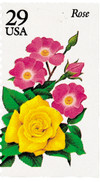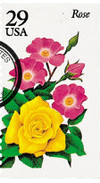
1994 29c Summer Garden Flowers: Rose
# 2833 - 1994 29c Summer Garden Flowers: Rose
$0.35 - $3.20
U.S. #2833
1994 Rose
Stamp Category: Commemorative
Series: Garden Flowers
Value: 29c – First-Class postage rate
First Day of Issue: April 28, 1994
First Day City: Cincinnati, Ohio
Quantity Issued: 35,202,800
Printed By: Bureau of Engraving and Printing
Printing Method: Lithographed and engraved
Format: Printed in four panes of 5 vertical se-tenant stamps
Perforations: 10.9 vertically
Why the stamp was issued: Partof the 5-stamp “summer” booklet set of the Garden Flowers Series, the rose stamp was one of the “bright, pretty American stamps” the US Postal Service was hoping people would buy.
The stamp fulfilled the then-current first-class postage rate of 29c.
About the stamp design: The stamp was designed by artist Ned Seidler, who had designed the1993 garden flowers stamps. Seidler used the same clever technique as before, with the lily appearing to be part of the same bouquet, along with the lily, gladiolus, zinnia, and marigold.
The painting was a combination of watercolor and gouache. Gouache is a thicker, opaque form of watercolor.
First Day of Issue Ceremony: The ceremony was held at the Greater Cincinnati, Ohio, Flower and Garden Show.
About the Series: On May 15, 1993, the USPS issued the first installment in the Garden Flower Series, which would honor flowers that bloom in each of the four seasons.
This series was born out of the 1992 Wildflowers issue. That project had begun when the USPS asked an artist to produce color sketches of a group of garden flowers. Instead, the artist gave the USPS illustrations of wildflowers. The USPS liked them so much, it decided to create a 50-stamp pane, showing wildflowers that can be found in each state.
The USPS still liked the garden flowers idea. Part of the push behind these stamps had come from the sale of stamps in supermarkets and other retailers. People said they wanted “bright, pretty American stamps.” The USPS decided flower booklets would please the public. It ran TV commercials and full-page advertisements in stamp publications announcing “The flowers are in bloom at your post office. Buy them while they last!” and “Pick up a bunch.” The Garden Flowers booklet was the first to be produced on the new Goebel booklet machine, which was the first to print multicolor covers.
The stamps were issued on May 15, 1993, in Spokane, Washington at the 55th annual Spokane Lilac Festival and International Lilac Society Convention. Though not announced at the time, these stamps were to be the first in a new series of seasonal flower booklets.
The second booklet in the series was issued on April 28, 1994, at the Greater Cincinnati, Ohio, Flower and Garden Show. It featured summer garden flowers. Some people took issue with one of the stamps, which used the word “gladiola” rather than gladiolus.
The third booklet in the series was issued on September 19, 1995, at the Quail Botanical Gardens in Encinitas, California. This booklet featured fall blooms, though some people noted that depending on where you live in the country, some of these flowers could grow in the summer or even the spring. One USPS representative responded that “The idea with this series was to show a grouping of flowers that would be together somewhere in a garden at the same time. It’s not scientific. It’s meant to be more for mass-market appeal, as opposed to botanical.”
The final booklet in the series was issued on January 19, 1996, in Kennett Square, Pennsylvania. The flowers selected for these stamps are the hardiest plants that grow anywhere in the country that experiences winter weather.
The history behind the stamp:
With its delicate blossoms and sweet fragrance, the rose is often thought of as a flower that requires a great deal of attention. But like all garden flowers, at one time it was found growing wild. Originating in central Asia, the rose spread to the Northern Hemisphere and could be found growing from the arctic cold of Alaska and Siberia to the desert heat of India and South America. Fossil roses, found in Colorado and Oregon, date as far back as 40 million years. Today roses continue to grow wild in all fifty states.
The Chinese were the first to cultivate wild roses. By the time of the Han Dynasty (202 B.C.-A.D. 220), rose gardens had become so popular that huge parks were devoted to these beautiful flowers. When land needed for agriculture was set aside to grow roses, food production became threatened, forcing the emperor to destroy many of the elaborate parks.
The Egyptians did a thriving business growing roses for the Romans. So enamored with roses were the Romans, that they would often spend thousands of dollars on roses for one feast. In fact, one order from Emperor Nero ran up a bill totaling almost $100,000! Even today the rose is still the world’s best known and most popular flower.
U.S. #2833
1994 Rose
Stamp Category: Commemorative
Series: Garden Flowers
Value: 29c – First-Class postage rate
First Day of Issue: April 28, 1994
First Day City: Cincinnati, Ohio
Quantity Issued: 35,202,800
Printed By: Bureau of Engraving and Printing
Printing Method: Lithographed and engraved
Format: Printed in four panes of 5 vertical se-tenant stamps
Perforations: 10.9 vertically
Why the stamp was issued: Partof the 5-stamp “summer” booklet set of the Garden Flowers Series, the rose stamp was one of the “bright, pretty American stamps” the US Postal Service was hoping people would buy.
The stamp fulfilled the then-current first-class postage rate of 29c.
About the stamp design: The stamp was designed by artist Ned Seidler, who had designed the1993 garden flowers stamps. Seidler used the same clever technique as before, with the lily appearing to be part of the same bouquet, along with the lily, gladiolus, zinnia, and marigold.
The painting was a combination of watercolor and gouache. Gouache is a thicker, opaque form of watercolor.
First Day of Issue Ceremony: The ceremony was held at the Greater Cincinnati, Ohio, Flower and Garden Show.
About the Series: On May 15, 1993, the USPS issued the first installment in the Garden Flower Series, which would honor flowers that bloom in each of the four seasons.
This series was born out of the 1992 Wildflowers issue. That project had begun when the USPS asked an artist to produce color sketches of a group of garden flowers. Instead, the artist gave the USPS illustrations of wildflowers. The USPS liked them so much, it decided to create a 50-stamp pane, showing wildflowers that can be found in each state.
The USPS still liked the garden flowers idea. Part of the push behind these stamps had come from the sale of stamps in supermarkets and other retailers. People said they wanted “bright, pretty American stamps.” The USPS decided flower booklets would please the public. It ran TV commercials and full-page advertisements in stamp publications announcing “The flowers are in bloom at your post office. Buy them while they last!” and “Pick up a bunch.” The Garden Flowers booklet was the first to be produced on the new Goebel booklet machine, which was the first to print multicolor covers.
The stamps were issued on May 15, 1993, in Spokane, Washington at the 55th annual Spokane Lilac Festival and International Lilac Society Convention. Though not announced at the time, these stamps were to be the first in a new series of seasonal flower booklets.
The second booklet in the series was issued on April 28, 1994, at the Greater Cincinnati, Ohio, Flower and Garden Show. It featured summer garden flowers. Some people took issue with one of the stamps, which used the word “gladiola” rather than gladiolus.
The third booklet in the series was issued on September 19, 1995, at the Quail Botanical Gardens in Encinitas, California. This booklet featured fall blooms, though some people noted that depending on where you live in the country, some of these flowers could grow in the summer or even the spring. One USPS representative responded that “The idea with this series was to show a grouping of flowers that would be together somewhere in a garden at the same time. It’s not scientific. It’s meant to be more for mass-market appeal, as opposed to botanical.”
The final booklet in the series was issued on January 19, 1996, in Kennett Square, Pennsylvania. The flowers selected for these stamps are the hardiest plants that grow anywhere in the country that experiences winter weather.
The history behind the stamp:
With its delicate blossoms and sweet fragrance, the rose is often thought of as a flower that requires a great deal of attention. But like all garden flowers, at one time it was found growing wild. Originating in central Asia, the rose spread to the Northern Hemisphere and could be found growing from the arctic cold of Alaska and Siberia to the desert heat of India and South America. Fossil roses, found in Colorado and Oregon, date as far back as 40 million years. Today roses continue to grow wild in all fifty states.
The Chinese were the first to cultivate wild roses. By the time of the Han Dynasty (202 B.C.-A.D. 220), rose gardens had become so popular that huge parks were devoted to these beautiful flowers. When land needed for agriculture was set aside to grow roses, food production became threatened, forcing the emperor to destroy many of the elaborate parks.
The Egyptians did a thriving business growing roses for the Romans. So enamored with roses were the Romans, that they would often spend thousands of dollars on roses for one feast. In fact, one order from Emperor Nero ran up a bill totaling almost $100,000! Even today the rose is still the world’s best known and most popular flower.












